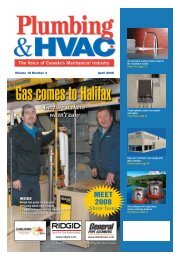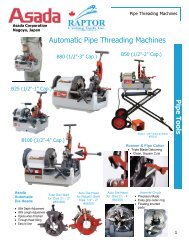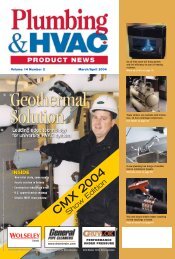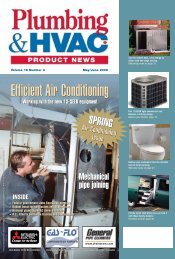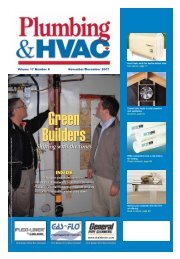March 2006 - Plumbing & HVAC
March 2006 - Plumbing & HVAC
March 2006 - Plumbing & HVAC
Create successful ePaper yourself
Turn your PDF publications into a flip-book with our unique Google optimized e-Paper software.
Hot Water HeatingFan coilsBringing hydronic and forced air systems togetherBy Roy CollverAlthough radiant floor heatingis the sexy darling of the “NewHydronics” set, there aremany other great ways to use “wet”heat.A common system uses tubingin the basement floor to warm theconcrete slab (creating a comfortableand useful living space downstairs) and a fan coilto heat the upper floors, allowing the easy addition ofair conditioning and ventilation.Fan coils come in a variety of shapes and sizes, withmany looking identical to your typical forced-air furnace,minus the gas piping and venting. Instead of agas or oil burner and heat exchanger, a fan coil has afinned heat exchanger coil we run heating fluidthrough. As the air blows across the coil, it picks upheat from the fluid and is sent through ductwork, distributingthe heat through the house much like a traditionalfurnace.Although most fan coils use standard sized andshaped metal ductwork, for some years now somemanufacturers have been making high velocity fancoils that operate at higher than normal static pressuresand use quite small, insulated flexible distributionducts, allowing them to easily to hide their bonesin standard wall and ceiling construction with fewtraces – a good choice in many applications.Any forced-air finned coil that uses hydronic heatingfluid as a heat source can be classified as a fan coil.These devices include furnace-type fan coils, compacthigh velocity units, hydronic unit heaters, air make-upunits and wall, floor, or ceiling mounted “forced flow”units. For variety, it doesn’t get much better than this!The beauty of fan coils is that you can design systemsto use them in a number of configurations and you cansize them to take advantage of each type of systemaccording to its best operating characteristics.Designing a systemThere are six basic factors you should consider whendesigning a system that will affect the heat output andoperating characteristics of a fan coil. These are:1) The minimum entering air temperature available2) The maximum desired discharge air temperaturerequired (A combination of factors 1 and 2 will tellyou the maximum heat input required to the fancoil.).3) The maximum desired air volume/velocity thatmust be heated on its way through the coil4) The desired entering fluid temperatureThis air handler is located in an upstairs closet,making it unnecessary to run ductwork from thebasement.5) The available fluid volume/velocityyou have to flow through the coil6) The desired temperature drop ofthe fluid as it passes through the coilAny fan coil you are considering touse in a hydronic system should havesupporting technical literature that willallow you to calculate all of the six factorslisted above.What degree of importance do weplace on these factors?The minimum entering air temperatureis always fixed by the applicationitself. For a residential heating systemfan coil, the entering air temperature isthe heating system return air temperature(usually 15 to 18°C).If the heating system brings in freshair from outdoors or from a heat recoveryventilator, there will be a furtherdrop in entering air temperature. If thefan coil is used to temper 100 percentincoming outdoor air; the entering airtemperature will depend entirely onthe physical location of the building;perhaps -30°C in Ottawa and 0°C inVictoria – check your ASHRAE weatherdata for the correct temperature in your area.The maximum required discharge air temperaturewill also depend on the application. For air make-upapplications, the discharge air temperature will be thesame or slightly less than the desired ambient airtemperature.For heating applications, the discharge air temperaturewill be above the desired ambient air temperature.How much higher it should be will depend on howoften we want to cycle our heating coil, based on howmuch air temperature differential we can live with.This is an importantpoint, and a big advantageto using fan coils.With the exceptionof variable speed andmodulating inputunits; fuel fired forcedairfurnaces have oneinput and by necessity,must short cycle atwarmer temperaturesin order to not overheatthe space. Theyalso have a much higherheat rise than mostfan coil units so thedischarge air temperatureis higher. Both ofthese factors can lead to occupant discomfort.Moving targetThe maximum desired air volume/velocity that youneed to be able to heat on its way through the coil is abit of a moving target. At times, ventilation requirementswill dictate this number, but normally it will bea function of how much heat (or cool) needs to bedelivered to a particular space.The desired entering fluid temperature used to be areal easy thing to figure out. All you had to ask was:How hot can the boiler go? This was before we had toactually pay real money for energy. Now the best questionis, can I run this sucker with a condensing boiler?Sometimes forced air makes sense in a hot waterheating application.Surprisingly, with fan coils, the answer is yes. We canmake that condensing boiler condense ALL the time –just let us size it properly for minimum supply temperaturesand maximum fluid temperature drops.Another advantage to designing for lower watertemperatures is that other low temperature heatsources such as solar panels and geothermal heatpumps can be included in the mix – something we willsee more of in the near future.The desired temperaturedrop of the fluid asit passes through thecoil also used to be areal easy thing to figureout. All you had to askwas: How can we maintaina 20-degree temperaturedrop acrossthe coil (to satisfy thosehigh temperature boilerguys)? Nowadays, weare faced with designingsystems to a higherstandard and with a littlemore finesse. Again,condensing boilerschange everything here.We want to try and design with as much temperaturedrop as possible so the return fluid to the boiler is ascool as possible, promoting better condensation andhigher efficiencies.The real deal here is: fan coils are multi-taskingdevices that can give the astute hydronics designer aserious amount of options. If you aren’t using themnow, you should really investigate all of the differenttypes and sizes of units available from the variousmanufacturers. You might be surprised at how oftenyou reach into that particular tool box for an applicationsolution.Roy Collver operates Mechanical Systems 2000 inCalgary and can be reached at royc@ms-2000.com.www.plumbingandhvac.ca February/<strong>March</strong> <strong>2006</strong> – <strong>Plumbing</strong> & <strong>HVAC</strong> Product News 23




